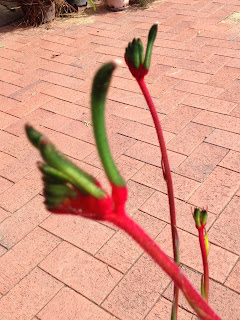This photo shows the characteristic kangaroo paw shape better while that below picks up the rich and vivid quality of the flower's red and green against a leafy green background - the plants behind it are red poppies of the kind that we use a symbol for Remembrance Day.
The reason I'm so excited is because I have tried to grow them repeatedly for many years and had no success. It seems they can be fussy about growing conditions and are susceptible to ink disease, a fungal disease which blackens the leaves and in severe cases can kill the plant (the stunning hybrids you can find in gardens all around the world now are less susceptible apparently). All my previous attempts at growing them have resulted in ink disease and death but if there's one thing certain about me and gardening it is that I don't like to be beaten so I try and try again.
Last year all but a few of the kangaroo paws I put in succumbed to ink disease so, instead of trying yet again to grow them in a garden bed, I planted the survivors in a large pot. To my surprise they thrived and now they are in bloom. It's a great thrill and reminds of my childhood visits to bushland at Red Hill on the Darling scarp where the hillside was carpeted with these spectacular flowers in Spring. Inspired, I've invested in some more plants. They're tiny at the moment but who knows, next year I may have my own carpet of these lovely flowers.


3 comments:
You say the aboriginals used them as a food plant. That is the part that interests me. Did they eat the flower or is there a tuber? How did they eat it? I am glad you finally had success in growing them Helen.
They have tubers which are tender and high in starch apparently and they were an important part of the Noongar diet. I haven't been able to find out how exactly how kurulbrang was eaten but other tubers were eaten raw, steamed in an earth oven or roasted over coals. You've got me interested now so I'll keep looking.
Don't forget to let me know Helen. It's a fascinating subject.
Post a Comment